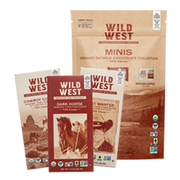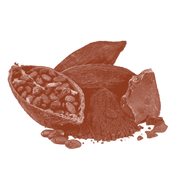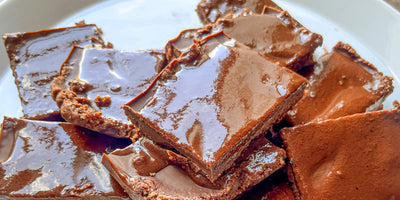As you browse the store looking for a bar of chocolate, you may notice various percentages of cacao listed. Is a 70% chocolate bar better in quality or have more health benefits than a 60% bar? What is a chocolate percentage anyway?

If you’ve ever been confused by the numbers displayed on a chocolate label, you’re not alone. Let’s take a closer look at understanding chocolate by the numbers, so you can get something that best suits your palate.
Cocoa Percentage Unwrapped
Depending on context, cocoa and cacao can mean different things, but when it comes to the percentage listed on chocolate, the two terms are used interchangeably.
Cocoa percentage refers to the actual amount of the chocolate, by weight, made from the cocoa bean. Total cocoa percentages include not just chocolate liquor, but also added cocoa butter. In other words: beans + any extra parts of beans = cacao or cocoa percentage.

As a general rule of thumb, the higher percentage of cocoa, the less sugar the bar will contain, and the darker the chocolate bar. For example, in a 70% cocoa dark chocolate bar the composition would be 70% cocoa (a combination of cocoa liquor/mass and cocoa butter) and 30% sugar, vanilla extract, etc. You can use the percentage as a general indicator of chocolate's intensity and flavor profile versus sweetness, as well as its melting point – important to note when cooking with and tempering chocolate. The higher the percentage, the more intense and less sweet the chocolate: dark chocolate labeled 50% will be far sweeter than a 70% bar.
How Much Cacao Is in Milk Chocolate vs. Dark Chocolate?
Not all chocolate is created equal. In fact, there are some key differences when it comes to milk versus dark chocolate. According to the FDA, milk chocolate must have a minimum of 10% cocoa solids and 12% milk solids (condensed milk, cream, dried milk, milk powder, etc.) to be considered milk chocolate. But here’s a hint: 38%–40% cacao is on the high side for milk chocolate, so any bar labeled 38% or more will be less sweet and more chocolaty.
Unlike milk chocolate, dark chocolate does not contain milk solids and is primarily made of cacao beans, sugar, and perhaps an emulsifier such as soy lecithin. Dark chocolate can range from 30% cacao content (sweet dark) to above 80% (extremely dark).
Why should I care about the cocoa content of a bar?
The percentage of chocolate doesn’t dictate its quality. Percentage alone doesn't let you know if the beans themselves were good quality and whether they were processed correctly to bring out their beautiful flavor notes. Fermentation, drying and roasting are as important as the beans themselves in producing a great flavor. Additionally, the chocolate makers process, and the other ingredients used will affect the product. For bean-to-bar chocolate fanatics, who value the terroir of cacao from various regions of the world, cocoa content not only defines the composition of the bar but is an expression of the craftsmanship of the chocolatier. When developing a new bar, craft chocolate makers (like Wild West Chocolate) adjust roast times and temperatures, grind times, and cocoa percentages to create what they believe is the best expression of the flavor profile for each distinct origin of cacao beans.

Craft makers typically use the highest-quality cocoa beans. When you purchase craft chocolate, you’re getting craftsmanship and quality, regardless of the percentage.
Some chocolate makers (and eaters) look at cocoa content in terms of its health benefits. Cacao is considered to be a superfood. The simple answer is the higher the percentage of cacao beans, the healthier the chocolate since the sugar content is less.
You’ll find more health benefits in high-percentage dark chocolate due to cacao’s antioxidant and nutrient-rich profile. Cacao beans are an excellent source of essential vitamins, minerals, antioxidants and anti-inflammatory agents.
If you're looking to consume chocolate for its health benefits, look for chocolate with higher percentages of cocoa. Chocolate with a high percentage of cacao are also lower in carbs because they contain less sugar. For those following a keto or paleo diet, high-percentage chocolate bars can help to satisfy chocolate cravings.
When it comes to healthy snacking, 70% dark chocolate is a good choice to get the flavor you’re craving while also getting a dose of the antioxidant benefits of dark chocolate. Of course, if you’re a dark chocolate devotee then you may want to look for something a little stronger. For those who search for the deep earthy notes of cacao, keep an eye out for a dark chocolate percentage over 85%.
What about 100% cacao chocolate? It make lack sugar, but the cacao butter brings a smooth creaminess that melts in the mouth. As for flavor, you can expect 100% chocolate to have an intense chocolate flavor, yet bitter, which makes it perfect for adding to savory dishes. Where it really shines is when used in baking for a really full-on, deeply chocolate flavor.
Other factors that contribute to the nutrition of chocolate include the following:
- Terroir (or environment). Cacao beans grow in pods on the Theobroma tree in tropical climates. These trees must be planted in nutrient-rich, fertile soil and cared for carefully until the pods are ripe for harvesting.
- Post-harvest processing. Chocolate makers roast cacao beans for use in the chocolate-making process. The treatment of the cacao beans during this process matters when it comes to retaining the nutrients and health benefits of chocolate. If cacao beans are highly roasted, this will destroy many of the antioxidants. On the other hand, cacao beans that are lightly roasted preserve the antioxidants and bring out their complex flavor profile.
- Any added ingredients or fillers. Added ingredients not only affect the flavor of chocolate but also the health benefits. To make milk chocolate, milk or milk powder is added. Milk powder contains proteins that bind to cacao’s antioxidants and reduce the effects of the health benefits. In general, the fewer ingredients you don’t know combined with high-quality ingredients you do recognize means a healthier chocolate product. Basically, if you can’t pronounce the ingredient or don’t know what it is, the chocolate isn’t as good for you.

Wild West Chocolate
The percentage displayed on Wild West chocolate refers to the raw cacao content, and varies depending on the bar. Whether it’s plain or flavored with ingredients like almonds and espresso, our dark chocolate is 70% cacao. As milk chocolate typically contains a lower amount of cacao than dark, it tends to be sweeter. However, at Wild West, we believe in "less sugar, more cocoa," allowing the intricate attributes of the cocoa bean to shine through. We ensure our oatmilk chocolate is never overly sweet by maintaining no less than 50% cacao.
The chocolate made at Wild West is organic, vegan, non-GMO, fair trade and ethically sourced. Our chocolate never contains emulsifiers, soy, gluten, dairy, and is always sweetened only with organic fruit.
Let the numbers be your guide
At the end of the day, the importance of the cocoa percentage is up to you. The next time you reach for chocolate, let those numbers be your north star. Finding the % on the label can help you choose a chocolate that matches your personal taste or one that pairs well with the ingredients in your recipes. If you want to try indulging in a higher percentage of chocolate, take a moment to check the percentage - your perfect chocolate match is just a number away.
 Bars
Bars
 Bear Claws
Bear Claws
 Merch
Merch
 Variety Packs
Variety Packs
 Shop All
Shop All
 Our Story
Our Story
 Sustainability
Sustainability
 Ingredients & Certifications
Ingredients & Certifications
 Artist Collaborations
Artist Collaborations
 FAQs
FAQs







